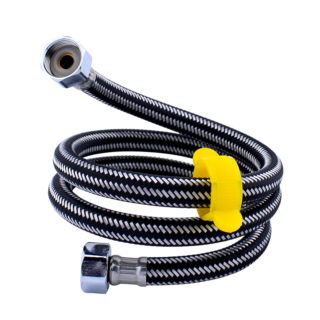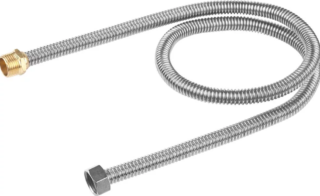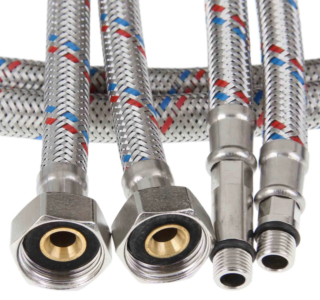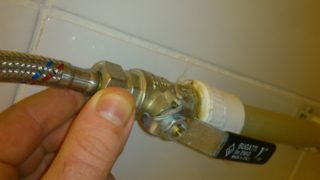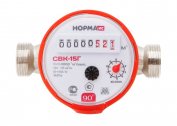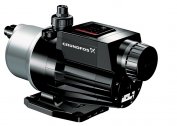For joining sanitary fittings, flexible metal-plated flexible water hoses are used. Thanks to the flexibility of rubber and metal, it is possible to conduct water even in hard-to-reach places: supplying it to the toilet bowl or connecting the mixer under the kitchen sink. When choosing a flexible water conduit, you need to rely on its technical characteristics: length, type of braid material.
Scope of application
As a rule, flexible eyeliners are used in such cases:
- mixer connection;
- shower cubicle device;
- water supply to the plumbing tank.
The hose can be used as a conductor only for hot / cold water or for two of its types. Some craftsmen use plumbing elements for installation on gas stoves. But doing this is undesirable. There are separate items for gas equipment.
Water Hose Classification
Despite the fact that the water hoses for hot and cold water perform the same function, they are divided into types according to the material of manufacture of the outer part - braids, according to purpose and type.
Production material
There are two types of water conduits:
- Bellows The body is made of stainless steel in the form of corrugations. Metal is more durable than rubber. The steel conduit inertly refers to temperature differences in the range from -50 to +250 degrees. A rubber hose cannot boast of such qualities.
- Reinforced. Inside the water conduit is made of elastic rubber. To protect it from sharp bends, tears, it is placed in a special metal sheath. This is the most popular type of product.
Braid, in turn, is made from the following materials:
- Aluminum. The most short-lived look. Serves no more than three years, after which it becomes worthless. Thin threads just break.
- Stainless steel. This type of material lasts up to 10 years. The maximum temperature at which a water-reinforced steel hose can operate is ─ / + 95 degrees.
- Nylon. This type of braid is even stronger than steel. The hose with nylon is called reinforced. It serves up to 15 years and can withstand up to +110 degrees. It is necessary if the pressure in the water supply network exceeds 5 atmospheres, and the working temperature of the water is above +85.
For water, it is better to take a water pipe with a stainless steel fitting. Aluminum behaves poorly over time.
Appointment
According to the designation, water conduits are divided into three types:
- for hot water (with a red thread in a braid);
- for cold (blue color in weaving);
- universal (has both threads).
Professionals recommend always installing the latest type of hose. You never know what will happen to the plumbing during operation.
Key selection criteria
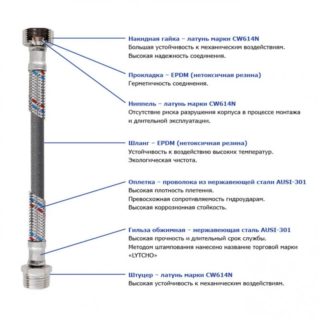 Going to the store, you need to clearly understand by what criteria it is better to take a hose. Professionals recommend paying attention to such points:
Going to the store, you need to clearly understand by what criteria it is better to take a hose. Professionals recommend paying attention to such points:
- Length of the product. It should be enough from one sanitary point to another with a small margin. Too long a water conduit will form strong bends and creases, which is undesirable. In turn, a purchased short hose will not fulfill its function. Strong tension should also not be.
- Diameter of union nut. All sizes (section, length) should be suitable for the existing technical holes and sleeves, on which the water conduit will be thrown.
- Braid material. It is better to take steel or nylon. Aluminum is short-lived. When buying one from another distinguished by weight. Steel is heavier.
- The purpose of the item.You need to navigate by the color of the woven thread, buying a hose for hot water or cold water.
- Fitting Must be stainless steel only. Plastic (PVC) and aluminum will not work for a long time. It is important that the fitting has a good grip of the braid. This will provide a tight connection.
- Union nut. It has an impressive weight and density. If it is too light, then it is made of low quality metal.
- The flexibility of the conduit. Bad rubber and braid will crack over time.
- Manufacturer. Some people think that hoses from a foreign manufacturer are better. However, domestic products win in several positions (price, strength, durability).
The products are based on the last resort or products are compared in one category (by type of braid material, diameter, length, etc.).
Connection Methods
You can connect a flexible conduit in one of two ways:
- Manually. The union nut is simply tightened with your fingers. It is not necessary to use any additional equipment. Specialists also assure that there is no need for special windings and seals.
- Using an adjustable wrench. It is needed not so much to tighten the nut more tightly, but to get to it in hard-to-reach places.
Experts advise against over-tightening the nut. Simply turn it all the way to a slight stop. Otherwise, the fitting, gasket and nut may become deformed over time.
Installation rules
To install a flexible hose, you must proceed as follows:
- Cover the water in a riser or the plumbing point from which work is carried out.
- Carefully dismantle the old hose, without applying much effort and without tugging it. If this rule is neglected, parts of the mixer may be damaged.
- If the kit includes a mesh nozzle (it acts as a filter), it is installed before mounting the hose.
- Connect the fittings and tighten the union nuts.
The mounted hose is checked for leaks. Turn on the water supply and monitor for possible leaks. If there are none along the entire length of the water conduit, the work is done correctly.
In case of malfunctions (leakage), remove the hose and contact the point of sale with it. If there is a check, the water element must be replaced with a better one.
If water leaks in the area of the union nuts, you can use the fum tape for sealing. To do this, you have to unwind the hose.
The cost of water hoses
The price of flexible conduits varies greatly depending on the following parameters:
- length of the product;
- section;
- type of braid material;
- type of hose;
- purpose of the conduit;
- manufacturer of products;
- the presence of additional options (heating).
In general, the price of a flexible hose for water supply is in the range from 39 to 770 rubles. and higher. How expensive an aqueduct to take and whether it is needed, each master decides for himself.
When buying plumbing items, it is always important to consult with the seller to avoid common mistakes.
